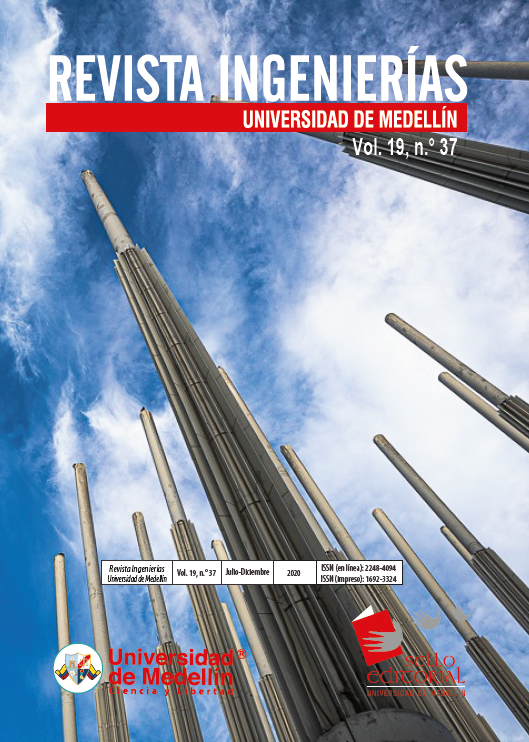Monitoring Value Indicators by Applying Data Mining, Business Process Management, and Continuous Improvement with Risk Management
Main Article Content
Abstract
Recognizing the behavior of processes through risk management and the assessment of value indicators (KPI), which stands for ‘Key Performance Indicators’, is something of paramount importance for institutions. One of the purposes of the continuous PDCA improvement cycle (Plan - Do - Check - Act) is to determine the state of the indicators and carry out processes reengineering to achieve the ideal goal. Risk management comes from the deviation of the indicators with respect to the proposed goals. In order to determine the relevant variables of a process, monitoring and control mechanisms must be set as an efficient way to obtain the knowledge based on the use of data mining techniques (MD). These concepts articulate in a model that was developed to achieve the ideal condition of the KPIs within an institution, and it is evidenced through a case study applied to a missional process in an institution of higher education. The establishment of data mining, business process management (BPM), PDCA continuous improvement cycle (Plan - Do - Check - Act), and risk management characteristics was used to define the components of the model. The aforementioned allowed to create an effective model, capable of meeting the needs of this research in particular, and able to be used as a model for future research. The proposed model was applied to a specific case, which allowed to describe the success of the theory, as well as the analysis stated.
Article Details
References
[1] 'ISOTools,' [En línea]. Available: https://www.isotools.org/soluciones/procesos/kpis-indicadores/.
[2] 'JLV Enterprises,' 2018. [En línea]. Available: https://jlvbusiness.com/2017/06/19/que-es-un-kpi-y-cuales-son-sus-caracteristicas/.
[3] T. P. y. C. Felden, 'On the restriction to numeric indicators in Performance Measurement Systems,' 15th IEEE International Enterprise Distributed Object Computing Conference Workshops, 2011.
[4] M. A. y. J. J. Jeng, 'A Tool Framework for KPI Application Development,' IEEE International Conference on e-Business Engineering, 2007.
[5] Z. Wang, Y. Qing y Y. S., 'The Research of Process Mining Assesment used in Business Intelligence,' IEEE, 11th International Conference on Computer and Information Science, 2012.
[6] E. Souza, 'Challenges in Performance Analysis in Enterprise Architectures,' IEEE Computer Society, 2013.
[7] G. Xiang, 'Towards the Next Generation Intelligent BPM - In the Era of Big Data,' Springer, 2013
[8] A. Orellana, C. Sanchez y L. Gonzalez, 'Aplicación del Modelo L* de minería de proceso al módulo Almacén del Sistema de Información Hospitalaria alas HIS,' 13th Laccei International Conference, 2015.
[9] R. X. J. Y. H. L. W. Z. Wencong Lu, 'Data mining-aided materials discovery and optimization.,'2017.
[10] A. K. M. Nidhi Tomar, 'A Survey on Data Mining Optimization Techniques.,' International Journal of Science Technology & Engineering | Volume 2 | Issue 06, December 2015.
[11] F. N. a. B. M. Christoph Gröger, 'Data Mining-driven Manufacturing Process Optimization.,'Proceedings of the World Congress on Engineering 2012 Vol III., p. Vol III., 2012.
[12] J. I. Gaiña Yungán, 'http://dspace.uniandes.edu.ec/handle/123456789/1815,' 12 2015. [En línea]. Available: http://dspace.uniandes.edu.ec/handle/123456789/1815.
[13] J. J. P. R. A. E. A. Surelys Pérez Jiménez, 'Modelo clustering para el análisis en la ejecución de procesos de negocio,' Investigación Operacional, pp. Vol 33, No. 3, 210-221, 2012.
[14] R. Alcover et al., 'Análisis del rendimiento académico en los estudios de informática de la Universidad Politécnica de Valencia aplicando técnicas de minería de datos', 2007 [internet]. Disponible en: http://bioinfo.uib.es/~joemiro/aenui/procJenui/Jen2007/alanal.pdf.
[15] 'Significados'. [internet]. Disponible en: https://www.significados.com/amenaza/.
[16] R. &. T. J. Arun, 'Analysis and Enhancement Of Process Models Using Scoring For Customer Relationship Management.,' International Journal of Computer Science Engineering and Information Technology Research., pp. 6(5), 75-84. Retrieved from http://www.tjprc.org/publishpapers/2-14-1476361205-9. IJCSEITR-Analysis and Enhancement of process model using scoring for Customer Relationship Management.pdf, 2016.
[17] U. &. Q. H. Shafique, 'A Comparative Study of Data Mining Process Models ( KDD ,CRISP-DM and SEMMA).,' International Journal of Innovation and Scientific Research, pp. 12(1), 217-222. Retrieved from http://www.ijisr.issr-journals.org/abstract.php?, 2014.
[18] G. Quiceno, L. Uribe y P. Noreña Cardona, 'Visualizaciones analíticas para la toma de decisiones en pequeñas y medianas empresas utilizando Data Mining', Cuaderno Activa, vol. 8, n.° 8, pp. 31-39, 2016.
[19] A. Rembert y C. Ellis, 'An Initial Approach to Mining Multiple Perspectives of a Business Process,' in TAPIA ‘09: The Fifth Richard Tapia Celebration of Diversity in Computing Conference: Intellect, Initiatives, Insight, and Innovations, pp. 35-40, 2010.
[20] 'ISOTools'. [inter net]. Disponible en: https://www.isotools.org/2015/02/20/en-que-consiste-el-ciclo-phva-de-mejora-continua/
[21] E. Cardoso, 'Towards a Methodology for Goal-Oriented Enterprise Management,' en 17th IEEE International Enterprise Distributed Object Computing Conference Workshops, 2013.
[22] X. Gao, 'Towards the Next Generation Intelligent BPM', Business Process Management. Lecture Notes in Computer Science, vol. 8094, pp. 4-10, 2013.
[23] M. A. Cetina, 'Gestión de procesos con BPM,' Tecnología, Investigación y Academia. Universidad Distrital Francisco José de Caldas, vol. 4, n.° 2, pp.45-56, 2016.
[24] 'Sinnexus Business Intelligence Informática estratégica'. [internet]. Disponible en https://www.sinnexus.com/business_intelligence/datamining.aspx.
[25] E. Blanco-Hermida, Algoritmos de clustering y aprendizaje automático aplicados a Twitter, Barcelona: Universidad Politécnica de Valencia, 2016.
[26] K. R. Saylam y S. Ozgur, 'Process mining in business process management:concepts and challenges,' en 2013 International Conference on Electronics, Computer and Computation (ICECCO), pp. 131-134, 2013.
[27] E. Leonard Brizuela y Y. Castro Blanco, 'Metodologías para desarrollar Almacén de Datos' Revista de Arquitectura e Ingeniería, Revista de Arquitectura e Ingeniería, vol. 7, n.° 3, pp. 1-12.
[28] U. Shafique y H. Qaiser, 'A Comparative Study of Data Mining Process Models ( KDD , CRISP-DM and SEMMA )', International Journal of Innovation and Scientific Research., vol. 12, n.° 1, 217-222.
[29] ICONTEC, Norma Técnica Colombiana NTC-31000. Gestión del Riesgo. Principios y Directrices, Bogotá: Icontec, 2011.
[30] T. Pidun y C. Felden, 'On the Restriction to Numeric Indicators in Performance Measurement Systems', 2011 IEEE 15th International Enterprise Distributed Object Computing Conference Workshops, Helsinki, 2011, pp. 96-102. DOI: 10.1109/EDOCW.2011.16.
[31] D. Wegener y S. Rüping, 'On Reusing Data Mining in Business Process - A Pattern- Based Approach', en International Conference on Business Process Management, Berlín, 2011, pp. 264-276.





